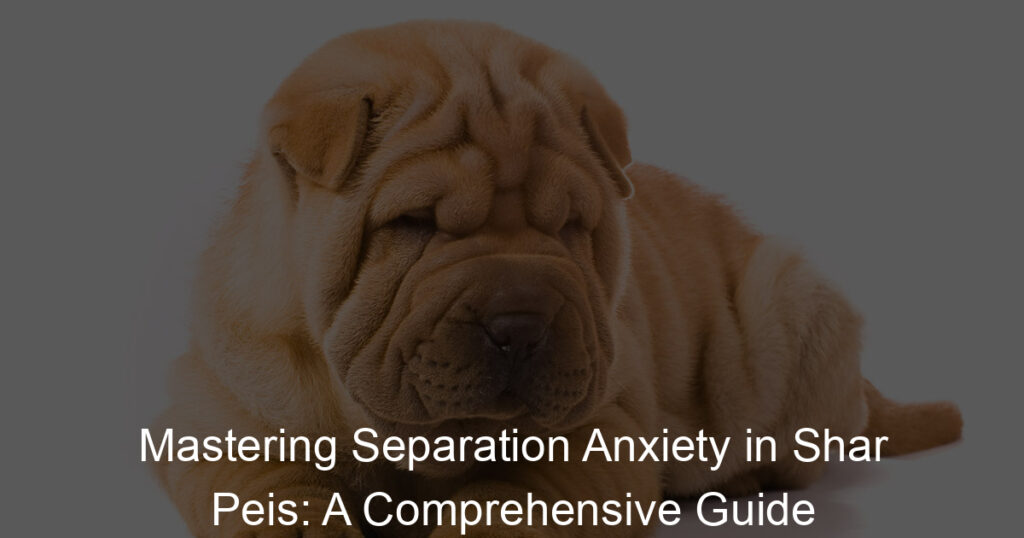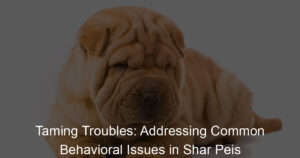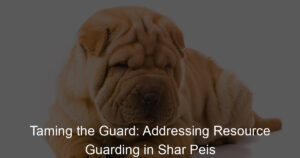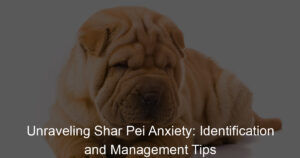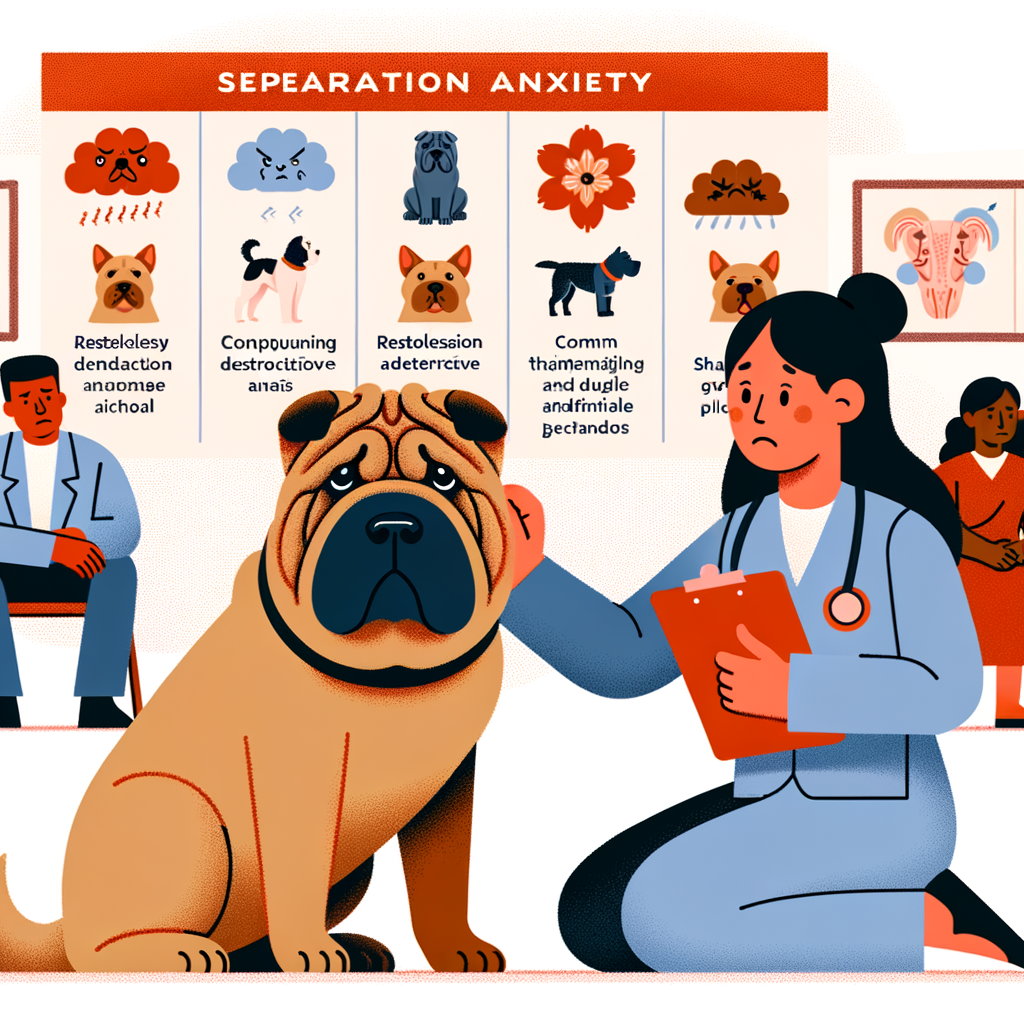
Understanding Separation Anxiety in Shar Peis
Separation anxiety is a common issue among dogs, particularly in Shar Peis. This article will help you understand what separation anxiety is, how it specifically affects Shar Peis, and what symptoms to look out for.
-
Defining Separation Anxiety in Dogs
Separation anxiety in dogs is a distressing condition that occurs when a dog is left alone or separated from its owners. It can manifest in various ways, such as excessive barking, destructive behavior, or attempts to escape. According to a study, around 20% of the 80 million dogs in the United States suffer from some form of separation anxiety.
-
Specifics of Separation Anxiety in Shar Peis
Shar Peis, in particular, are known for their strong attachment to their owners. They are a breed that thrives on companionship and can become particularly distressed when left alone. This breed’s unique characteristics, such as their loyalty and protective nature, can make them more susceptible to separation anxiety.
It’s important to note that every Shar Pei is different, and not all will experience separation anxiety. However, understanding this potential issue can help you better care for your pet.
-
Shar Peis Anxiety Symptoms
Separation anxiety in Shar Peis can manifest in various ways. Some common symptoms include:
- Excessive barking or howling when left alone
- Destructive behavior, such as chewing furniture or scratching doors
- Attempts to escape from a room or crate
- Pacing or restlessness
- Accidents in the house despite being house trained
If you notice any of these symptoms in your Shar Pei, it’s important to consult with a veterinarian or a professional dog trainer. They can provide guidance on how to manage and alleviate your pet’s anxiety.
In conclusion, understanding separation anxiety in Shar Peis is crucial for their wellbeing. By recognizing the signs and knowing how to respond, you can help your pet live a happier, healthier life.
Managing Separation Anxiety in Dogs
Separation anxiety in dogs is a common issue that many pet owners face. It can lead to a variety of behavior problems, especially in certain breeds like the Shar Pei. In this section, we will explore the behavior problems related to separation anxiety in Shar Peis and how to identify them.
Shar Peis Behavior Problems
Shar Peis are known for their loyalty and protective nature. However, these traits can sometimes lead to behavior problems, particularly when they are left alone for long periods. Here are some ways to identify these problems and understand their link to separation anxiety.
- Identifying Behavior Problems
- Link between Behavior Problems and Separation Anxiety
Behavior problems in Shar Peis can manifest in various ways. Some common signs include excessive barking, chewing on furniture, and pacing. They may also show signs of distress like drooling, panting, or trying to escape. It’s important to note these behaviors, as they can be indicators of separation anxiety.
Separation anxiety is often the root cause of these behavior problems. When left alone, Shar Peis may feel anxious and resort to destructive behaviors as a way to cope. For instance, a study showed that 20% of dogs with separation anxiety tend to bark excessively when left alone. This shows a clear link between separation anxiety and behavior problems in dogs.
In conclusion, understanding your Shar Pei’s behavior problems is the first step towards managing their separation anxiety. By identifying these issues early, you can take the necessary steps to help your dog feel more comfortable when they are alone.
Dog Separation Anxiety Solutions
Dealing with a dog’s separation anxiety can be a challenging task. However, there are various solutions that can help manage this issue effectively. Let’s explore some of these solutions:
- Training Techniques
- Use of Toys and Distractions
- Professional Help
Training techniques are a fundamental part of managing your dog’s separation anxiety. These techniques can help your dog feel more comfortable when left alone. One popular method is the ‘Gradual Departure’ technique. This involves gradually increasing the amount of time you spend away from your dog, starting with just a few minutes and gradually increasing to longer periods. This helps your dog get used to the idea of being alone without feeling abandoned.
Another effective solution is the use of toys and distractions. A toy that your dog loves can provide comfort and distraction when you’re not around. For instance, puzzle toys that dispense treats can keep your dog occupied for hours. These toys not only provide entertainment but also stimulate your dog’s mind, reducing feelings of anxiety.
If your dog’s separation anxiety is severe, it may be necessary to seek professional help. A professional dog trainer or a veterinary behaviorist can provide personalized strategies and techniques to manage your dog’s anxiety. They can also help you understand the root cause of the anxiety, which is crucial in finding a long-term solution.
In conclusion, managing a dog’s separation anxiety requires patience and consistency. Whether you choose to use training techniques, toys and distractions, or seek professional help, remember that every dog is unique and what works for one might not work for another. Therefore, it’s essential to try different methods and see what works best for your furry friend.
Shar Peis Training Tips
Training your Shar Pei can be a rewarding experience for both you and your furry friend. Here are some tips to make the process easier and more effective.
-
Establishing a Routine
Just like humans, dogs thrive on routine. Establishing a consistent schedule for meals, walks, and playtime can help your Shar Pei understand what to expect each day. This can reduce anxiety and make training more effective. For example, if you always take your dog for a walk after breakfast, they’ll start to anticipate this activity and will be more likely to behave well during it.
-
Positive Reinforcement
Positive reinforcement is a powerful tool in dog training. This involves rewarding your Shar Pei for good behavior, rather than punishing them for bad behavior. Rewards can be treats, toys, praise, or anything else your dog loves. For instance, if your Shar Pei sits on command, give them a treat and lots of praise. This will encourage them to repeat the behavior in the future.
-
Gradual Desensitization
Shar Peis can be sensitive to new experiences and environments. Gradual desensitization can help them adjust. This involves slowly introducing your dog to new things in a controlled and positive way. For example, if your Shar Pei is scared of car rides, start by letting them explore a parked car. Reward them for staying calm. Gradually increase the intensity of the experience, always rewarding calm behavior. Over time, your Shar Pei should become less anxious about car rides.
Remember, every dog is unique. What works for one Shar Pei might not work for another. Be patient, stay positive, and don’t be afraid to try different strategies. Happy training!
Anxiety Disorders in Shar Peis
Shar Peis, like humans, can also experience anxiety disorders. These disorders can significantly impact their mental health and overall well-being. Understanding the importance of mental health in Shar Peis and the impact of anxiety disorders is crucial for every Shar Pei owner.
Shar Peis Mental Health
Just as physical health is important for a dog’s well-being, so is their mental health. Mental health in Shar Peis is a topic that needs more attention. Let’s delve into the importance of mental health in Shar Peis and the impact of anxiety disorders.
- Importance of Mental Health in Shar Peis
- Impact of Anxiety Disorders on Mental Health
Mental health is as important in Shar Peis as it is in humans. A Shar Pei with good mental health is more likely to be active, playful, and sociable. They are more likely to have a healthy appetite and a regular sleep pattern. Good mental health in Shar Peis also means they are less likely to show aggressive or destructive behavior.
Anxiety disorders can have a significant impact on a Shar Pei’s mental health. Dogs with anxiety disorders may show signs of nervousness, fear, or aggression. They may also engage in destructive behaviors such as chewing on furniture or excessive barking. In severe cases, anxiety disorders can lead to physical health problems like loss of appetite and sleep disorders.
In conclusion, mental health plays a pivotal role in the overall well-being of Shar Peis. Anxiety disorders can negatively impact their mental health, leading to behavioral and physical health issues. As a Shar Pei owner, it is important to understand and address these issues to ensure your pet’s overall well-being.
Treating Anxiety in Shar Peis
When it comes to treating anxiety in Shar Peis, there are several effective methods to consider. These include medication, behavioral therapy, and alternative treatments. Each of these methods has its own benefits and can be used individually or in combination depending on the severity of the anxiety and the specific needs of your Shar Pei.
- Medication
- Behavioral Therapy
- Alternative Treatments
Just like humans, dogs can also benefit from medication to manage their anxiety. There are several types of medication that can be prescribed by a vet to help calm your Shar Pei and reduce their anxiety symptoms. These include selective serotonin reuptake inhibitors (SSRIs), tricyclic antidepressants (TCAs), and benzodiazepines. It’s important to remember that medication should always be used under the supervision of a vet and it’s not a cure-all solution. It should be used in combination with other treatments for the best results.
Behavioral therapy is another effective method for treating anxiety in Shar Peis. This type of therapy involves training your dog to react differently to the situations that cause them anxiety. For example, if your Shar Pei gets anxious when left alone, you can train them to associate being alone with positive experiences, like getting a treat or playing with a favorite toy. Behavioral therapy requires patience and consistency, but it can lead to long-term improvement in your dog’s anxiety.
Finally, there are also alternative treatments that can be used to manage anxiety in Shar Peis. These include things like aromatherapy, massage, and even acupuncture. While these treatments may not be as widely recognized as medication or behavioral therapy, they can still be very effective. For example, aromatherapy can help to create a calming environment for your dog, while massage can help to reduce physical tension and promote relaxation. As with any treatment, it’s important to consult with a vet before starting any new treatment regimen.
In conclusion, treating anxiety in Shar Peis involves a combination of medication, behavioral therapy, and alternative treatments. By understanding these methods and working with a vet, you can help your Shar Pei live a happier, less anxious life.
Coping with Shar Peis Anxiety
Dealing with anxiety in Shar Peis can be a challenging task. However, with the right approach and understanding, you can help your furry friend navigate through these tough times. Here are some strategies to consider:
- Supporting Your Shar Pei During Anxiety Attacks
When your Shar Pei is experiencing an anxiety attack, it is crucial to remain calm and supportive. Avoid punishing or scolding your dog during these episodes as it may increase their stress levels. Instead, try to distract them with their favorite toy or treat. Remember, your Shar Pei looks to you for comfort and reassurance during these challenging times.
- Creating a Safe Space
Just like humans, dogs also need a safe and comfortable space where they can retreat when they feel anxious. This could be a specific room, a corner in your home, or even a crate. Make sure this space is filled with your dog’s favorite things like toys, blankets, and treats. This will help them feel secure and reduce their anxiety levels.
- Importance of Regular Exercise and Socialization
Regular exercise and socialization play a vital role in managing your Shar Pei’s anxiety. Exercise helps to release pent-up energy and reduces stress, while socialization helps your dog to become more comfortable in different situations. Try to take your dog for a walk or play fetch in the park at least once a day. Also, consider arranging playdates with other dogs to help your Shar Pei become more social.
In conclusion, coping with a Shar Pei’s anxiety requires patience, understanding, and consistency. Remember, every dog is unique and what works for one might not work for another. Therefore, it’s important to try different strategies and see what works best for your Shar Pei.
| Strategy | Description |
|---|---|
| Support During Anxiety Attacks | Stay calm and distract your dog with their favorite toy or treat. |
| Creating a Safe Space | Provide a comfortable space filled with your dog’s favorite things. |
| Regular Exercise and Socialization | Ensure your dog gets regular exercise and socialization opportunities. |

